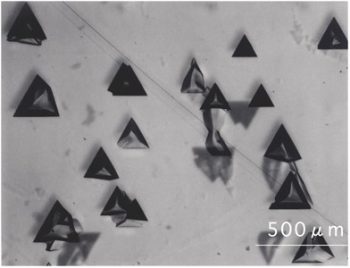Sapphire is chemically very stable and is almost insoluble in acid and base solutions. It is also relatively resistant to plasma, so it is used for windows and parts of etching equipment. However, it is not completely insoluble, and is slightly affected by highly corrosive solutions such as hydrofluoric acid (HF).
The figure below shows an observation of the surface of a c-plane sapphire substrate etched with potassium hydroxide solution, showing triangular etch pits reflecting the crystal structure. Etch pits are a phenomenon that becomes apparent when defects in the crystal exposed on the surface and processing strain on the surface are preferentially eroded. Therefore, to improve chemical resistance, it is desirable to use a crystal with fewer defects and a precision polishing finish.

Defect density by the growth methods on sapphire
| Etch Pit density (EPD) | Purpose | |
|---|---|---|
| Flame-Fusion (Verneuil) method | ~106/cm2 | Jewelry applications, watch windows, etc. |
| CZ method | 104〜105/cm2 | Research samples, small diameter wafers, etc. |
| TSMG method | 102〜103/cm2 |
Mass production wafers, sapphire windows, sapphire parts, etc. |
※The TSMG method : the Top Seeded Melt Growth method
The TSMG method is a SHINKOSHA original method for growing large-sized sapphire crystals.